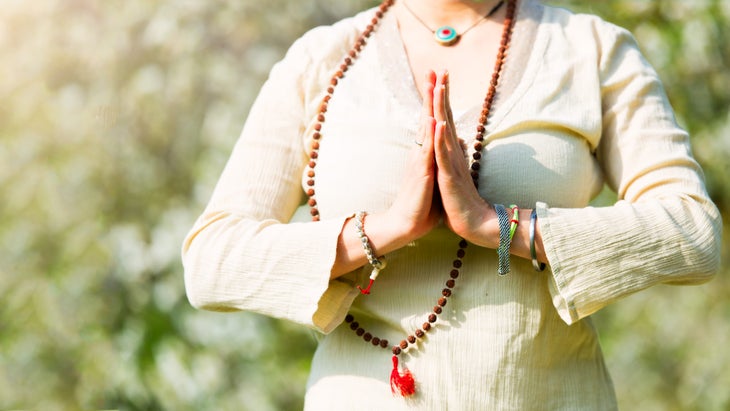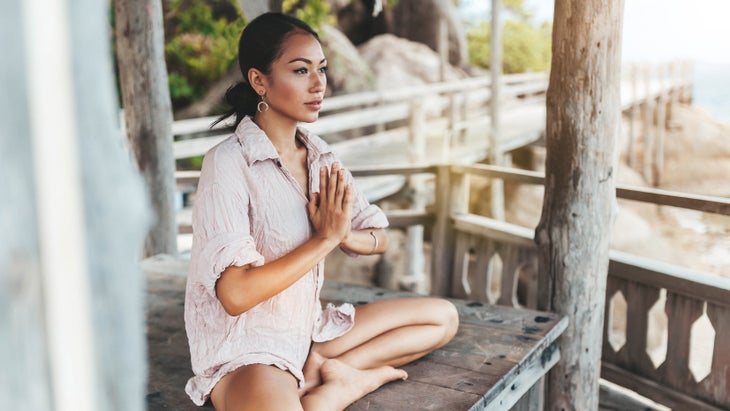Heading out the door? Read this article on the new Outside+ app available now on iOS devices for members! Download the app.
Anxiety is the most common mental health issue in the world, affecting 40 million adults in the United States and 284 million (1 in 13) around the world. While many forms of effective treatment are available, the majority of people with anxiety disorders remain untreated due to a lack of medical or financial resources or cultural stigma around mental illness.

Of these disorders, the most common is generalized anxiety disorder (GAD), which is characterized by chronic and excessive worry and can lead to difficulty concentrating and sleeping, as well as increased fatigue and muscle tension. GAD affects around 3 percent of people in the U.S., is more common among women, and is likely being exacerbated by the COVID-19 pandemic (though it’s maybe still too soon to tell since GAD takes about six months to diagnose).
The mental health benefits of meditation are well documented and a growing body of research shows the efficacy of structured mindfulness-based interventions like Mindfulness-Based Stress Reduction (MBSR) and Mindfulness-Based Cognitive Therapy (MBCT) to reduce symptoms of anxiety and depression. Physical asana such as Hatha Yoga has also been shown to offer some relief from symptoms of anxiety, though these studies are often limited in size, scale, and rigor and the evidence is often anecdotal.
see also The Key To Releasing Stress And Paving The Way To Better Poses? Caring For Your Psoas
The Latest Study on Yoga and Anxiety
New research, published in August in the Journal of the American Medical Association (JAMA), compared a Kundalini Yoga practice to cognitive behavioral therapy (CBT), one of the most common therapeutic treatments for anxiety. Similar to a yoga or meditation practice, CBT helps patients illuminate their patterns and learn how to break free from them. Researchers wanted to know whether yoga was as effective as CBT for the treatment of generalized anxiety disorder (GAD), as well as whether yoga and CBT were superior compared to psychological control (stress education).
In a JAMA Psychiatry podcast, Naomi M. Simon, MD, the lead author of the study and a professor in the department of psychiatry at New York University’s Grossman School of Medicine, reiterated that while yoga has long been sought after as a stress-management tool, the actual research about yoga’s efficacy for anxiety disorders is relatively limited, and the data is often mixed and has weaknesses associated with it.
“The purpose of our study was to develop a very rigorous efficacy study that would compare against the gold standard treatment [CBT] as well as have a control condition,” Simon said on the podcast.
see also How to Form a New Relationship with Your Anxiety

Why Yoga Works to Tame Anxiety
In 2018, Sat Bir S. Khalsa, PhD, a co-investigator in the new study and an expert in Kundalini Yoga, had developed preliminary evidence for the anxiolytic (anxiety inhibiting) effects of the practice. The protocol for the 2020 study was modeled after Yogi Bhajan’s well-known Kundalini Yoga method and adapted by Khalsa at the Guru Ram Das Center for Medicine & Humanology. The researchers hypothesized that Kundalini Yoga is an effective form of treatment compared with other yoga practices that are solely physical since it takes a multifaceted approach: physical postures and exercises, breath regulation, deep relaxation techniques, and meditation and mindfulness components.
see also A New Report Details Decades of Abuse at the Hands of Yogi Bhajan
“We think it’s important to have mindfulness aspects of yoga—and that’s probably one of the things that make yoga effective for anxiety,” Simon said.
The randomized clinical study divided 226 adults with GAD into three groups: CBT, Kundalini Yoga, and stress education. Since the focus of the research was comparing yoga to CBT, those two groups were larger with 93 in the yoga group and 90 in the CBT group (the remainder were part of the control group). To ensure that every subject received adequate attention and instruction, each group was divided into smaller subgroups of three to six people that participated in two-hour sessions over 12 weeks. Results were rated by the subjects’ Clinical Global Impression (CGI) scores at the end of three months.
Preliminary results of the study found that yoga was 54 percent more effective than the stress education control, which was expected, though still not as effective as CBT which showed an efficacy of 71 percent. The results showed that yoga was not effective as a first-line treatment even at a six-month follow-up, which came as a surprise to the authors. Still, Simon said the results provide solid evidence that yoga may be helpful for some patients with GAD, offering clinicians a broader arm for possible treatment. “If patients don’t have access or are not willing to go to therapy, yoga may be helpful as a first-line approach for them,” Simon said.
Ravi Singh, a Kundalini Yoga teacher for more than 45 years, says the practice can help people with anxiety not just manage their symptoms but thrive. “Talk therapy is a great adjunct to yoga, but trauma and anxiety suffuse every stratum of our being and thus, a multi-faceted approach is in order,” Singh says. “So many methods now seem to be predicated on helping people to simply cope.” (A welcome reminder that despite recent allegations against Kundalini’s problematic lineage, the practice itself may still be a reliable resource.)
see also 11 Yoga Practices for Working Through Stress and Anxiety
Next Steps
While many effective treatment options for GAD exist—CBT, mindfulness meditation, yoga, and psychosocial treatment—Simon wants to understand why yoga wasn’t a greater driver of success rates. She said she plans to do a follow-up study to dive deeper into the underlying factors and find out more. A patient’s preference is important, too, Simon notes. When it comes to who should try yoga versus who should stick with CBT or other forms of conventional therapy, a personalized approach that examines the full spectrum of underlying causes may be of benefit.
“There’s a great need for understanding what’s driving the underlying biology and neurobiology of response to alternative and complementary interventions like yoga and mindfulness,” Simon said. “Patients should be encouraged to seek help and not go through it alone.”
see also Beat Stress and Anxiety with DIY Mindful Hypnotherapy